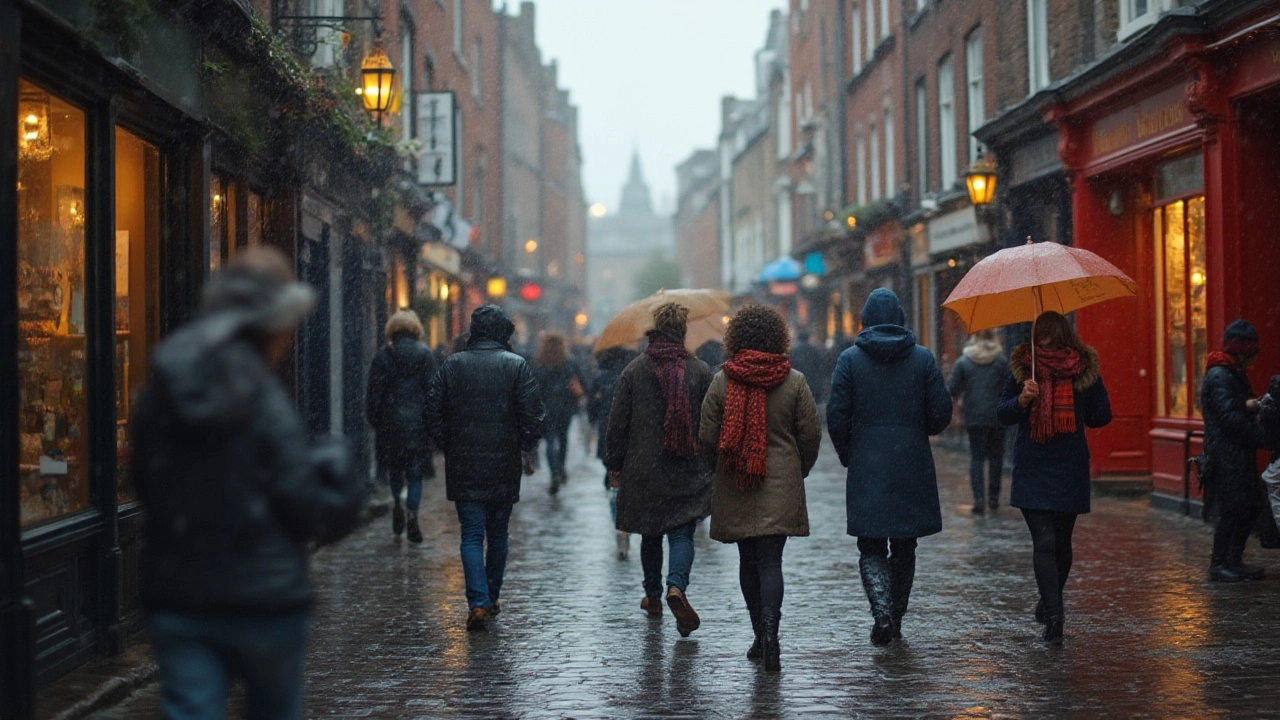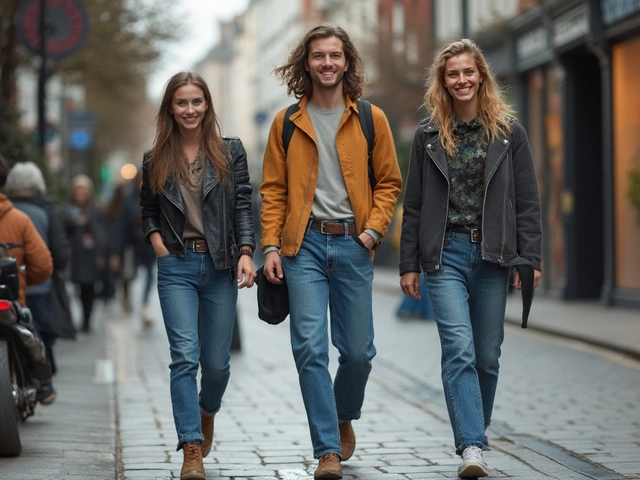There’s a running joke in Ireland: if you don’t like the weather, just wait five minutes. From misty mornings on Achill Island to biting winds swirling down Dame Street, the cold here doesn’t make life easy for anyone who forgets their jacket. Locals, tourists, and even the postman on his bike know the panic of leaving home without something warm. And, as any Irish mammy would say, “You’ll catch your death!” Ireland weather can catch you off guard, but jackets are more than just something to toss on as you dash out the door.
The Irish Climate: More Than Just a Bit Chilly
Think Ireland, and you probably imagine soft rain, rolling green hills, and people bundled up on Grafton Street. There’s a good reason. While Ireland doesn’t sink into Siberian-style winters, it rarely has truly warm days. According to Met Éireann, the average temperature in Dublin in January hovers around 5°C, and even summer days can surprise you with brisk wind and drizzle. In places like Galway and Donegal, the Atlantic seems to invent new ways for cold and damp to get into your bones.
Layering up isn’t just a fashion statement here. Jackets are an absolute necessity, not just for comfort but because damp cold in Ireland is different. That mix of wind and water chills you faster than the dry cold found in some other parts of Europe. There’s a word for those kind of days—raw. Your jacket is your shield, whether you’re hiking the Wicklow Way, wandering around Cork city, or waiting fifteen minutes for a Luas that’s gone missing.
Walk the Cliffs of Moher or stand in a queue outside Croke Park in February, and you’ll quickly see why Irish people don’t mess around with layering up. Locals might swear by their rainproof Regatta or Berghaus jackets, brands that have a cult following across the island, while others stand by classic waxed Barbour or even trusty Penneys bargains. You won’t get far during the Six Nations or Christmas shopping in Belfast without seeing half the crowd zipped up tight.
Then there’s the coastal wind. The Irish Sea has a habit of cutting through whatever cheap hoodie you thought would do the job. The truth is, most Irish counties get over 150 days of rain per year, and even the "good" days can drop by 10 degrees before sunset. Tourists quickly learn that T-shirts and optimism are not a match for Ulster winds.
Most studies point out the dangers of cold, wet conditions—hypothermia, increased chances of illness, slower recovery from sports injuries. So, when you move to Ireland or are here on a business trip in January, bring a jacket that can take a soaking and block the wind.
The Real Purpose of a Jacket: Warmth, Health, and Irish Wisdom
You might think, “Isn’t the purpose of a jacket obvious?” In Ireland, though, the answer goes way beyond just staying warm. The right jacket keeps your skin dry, guards against windburn, preserves your body’s heat, and cuts your risk of getting sick from exposure.
According to the HSE, the Irish Health Service, people exposed to cold, damp conditions are at higher risk for colds, flus, and even more serious illnesses if they’re not protected properly. That’s why Irish parents “go on” about proper dressing; it’s not an old wife’s tale, but a practical response to local weather. For the elderly and kids, who lose heat quickly, jackets aren’t fashion— they’re protection.
When that North Atlantic wind blows through Galway, you feel it in your bones. It saps your energy. It makes everything feel harder, whether you’re commuting or just heading up to your local Centra. Mayo GAA fans on cold match days throw on every layer they own, and workers on the docks in Waterford still stick to their high-vis windproofs and insulated fleeces for a reason.
- Maintaining core warmth: Your body loses up to 50% of its heat from the head and torso. A good jacket traps your body heat, keeping you functional and alert.
- Health: Cold, damp conditions raise your risk for colds and chest infections. According to a 2024 Irish Heart Foundation report, “Keeping warm outdoors is one of the best ways to maintain immune function.”
- Freedom to move: The right jacket lets you keep active all year. You can take a spontaneous walk along the Grand Canal or join in community football in Louth without feeling miserable.
- Mental comfort: That psychological boost from feeling cosy makes all the difference during long grey Irish stretches when the sun doesn’t show up.
And look, Irish friends will have different opinions about “the best jacket.” Some swear by the Gore-Tex in a Columbia hiking shell. Others need an Aran wool cardigan under a waterproof North Face if they’re spending time near Connemara. The underlying purpose—staying healthy, staying happy in grim weather—never changes.

Staying Stylish—and Sensible—in Irish Outerwear
Practicality is king in Ireland, but that doesn’t mean ignoring personal style. Lumberjacks in Kerry don’t generally worry about the cut of their puffer, but in Dublin you’d be surprised how many people pull off looking smart while staying dry. Go to an outdoor gig in Phoenix Park or the Galway Races and you’ll see the full range—from Penneys parkas to Patagonia shells. Irish fashion has adapted to its unpredictable climate with an emphasis on sharp, functional looks.
A few tips learned after years in Irish weather:
- Look for jackets with solid, waterproof seams—especially from trusted brands like Regatta, The North Face, and Berghaus (all found in Elverys or Trespass shops or even at Dunnes Stores).
- Think about down versus synthetic insulation. Down is lighter and warmer, but synthetic performs better if you get caught in a downpour, which, let’s be honest, will happen.
- Zips, cuffs, and hoods matter. You’ll regret not having a hood when squalls hit suddenly in Howth. Adjustable cuffs help trap heat, and taped zips block out wind.
- Pockets with secure closures. Phones, Leap cards, and loose coins need somewhere safe during a November walk by the Shannon.
- Length counts. Thigh-length coats keep more of you protected when umbrella-wrecking winds howl through Limerick city streets.
If you want to see proper Irish jacket culture in action, walk into the Penny’s in O’Connell Street during a back-to-school rush. Or tap into second-hand gems at Nine Crows or Siopaella, where vintage raincoats and fleeces get a second life. Chrome café cyclists swear by high-vis windbreakers, and weekend walkers in the Wicklow mountains drag out insulated Trespass parkas or the classic black “Rugby Special” anoraks. Nobody’s pretending they’ll ever have California sunshine—so style means working with the weather, not against it.
| City/Region | Avg. Winter Temp (°C) | Rainy Days per Year | Popular Jacket Type |
|---|---|---|---|
| Dublin | 5 | 128 | Waterproof Shells |
| Galway | 6 | 209 | Insulated Raincoats |
| Cork | 5 | 180 | Padded Parkas |
| Belfast | 6 | 157 | Softshell Jackets |
| Limerick | 5 | 156 | Puffer Jackets |
Festival-goers, sports fans, and gig workers all prove that you can dress for Irish weather and still look good. The best advice? Choose durability and comfort, then go wild with colour or patterns if that’s your style. Irish weather means you’ll get wear out of every jacket you own and you’ll never find it gathering dust in the wardrobe.
Getting the Best Out of Your Jacket: Local Tips for Irish Days
So, you’ve invested in something warm and waterproof. How do you make it work for you day in, day out? Life in Ireland can throw wild weather swings in one afternoon—especially in places like Sligo or along the Wild Atlantic Way. Here’s how to get the most comfort and mileage from your jacket:
- Layer up like locals: A light fleece or wool jumper under your jacket makes it easier to adapt when temperatures change. Irish weather might seem endless, but the microclimates are real—one minute it’s sleeting, next it’s muggy.
- Keep jackets by the door: Most Irish hallways have coat hooks within grabbing distance for those mad dashes to catch the DART or bring in the turf. A good habit if you want to stay dry.
- Train your eye for repairs: The Irish are a thrifty bunch—patches on elbows, sewing up split linings, waterproofing sprays. There’s no shame in keeping a beloved jacket going for years. Check out Oxfam or thrift shops for extra treasures or hand-me-downs.
- Think beyond fashion labels: While people love their Superdry and Columbia, sometimes the old reliables from the army-navy stores or your uncle’s vintage stash are far better at keeping the cold out than any pricey logo.
- Check the forecast: Get in the habit of checking Met Éireann’s daily updates. It’s not always accurate to the minute, but it’ll remind you to grab your jacket before the heavens open up in Kilkenny or Tralee.
- Don’t forget about breathability: Choose jackets that won’t leave you sweaty after a brisk walk, because the Irish cold isn’t always freezing—it’s sneaky, damp, and clammy. Look for those clever venting pockets or underarm zips.
- Bring a backup: Day trips in Wicklow, Tipperary, or hiking up Croagh Patrick? Toss a packable jacket or fold-up poncho in your bag. You’ll thank yourself when the drizzle turns to a downpour.
- Wash and maintain: Follow washing instructions for technical fabrics. Mud, salt spray, and spillages are common when you’re out on the Irish coast, so keep things clean to preserve waterproofing and warmth.
- Don’t leave wet gear balled up: Drape jackets properly so they dry out. Nothing’s worse than pulling on something cold and clammy before a run to Tesco or a special event in Temple Bar.
- Watch for sun and wind: Irish weather is notorious, but sunny spells can come out of nowhere. Lightweight jackets with a UPF rating (yes, some brands offer these!) are actually useful on the ever-brightening beaches of Wexford.
Life in Ireland means learning to respect and prepare for unpredictable weather. Ask anyone who’s lived through a freak April hailstorm or the famous “Beast from the East” in 2018—jackets aren’t optional, they’re survival. Wear them proudly, care for them, and see if you don’t start to enjoy those brisk mornings and wild sea walks a bit more.
The Irish tradition of caring for your jacket, passing them down, and buying for both weather and wear shows how something as ordinary as a coat matters. It’s a symbol of common sense and a little bit of home comfort—plus, it keeps you from catching the flu the next time there’s "a grand soft day" (which, let’s be honest, could be tomorrow).


